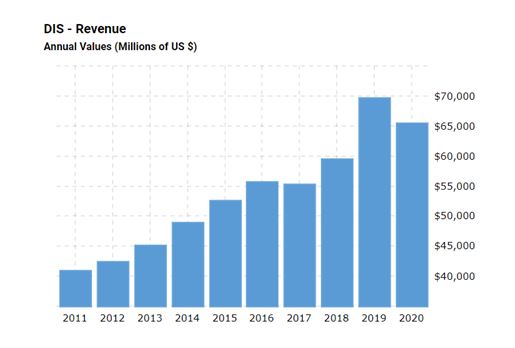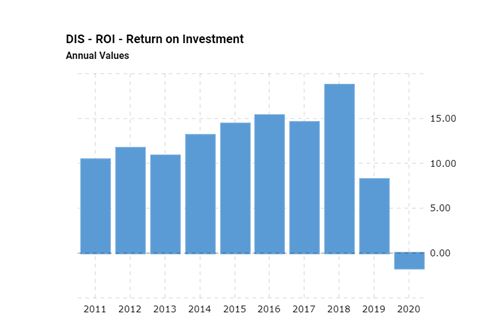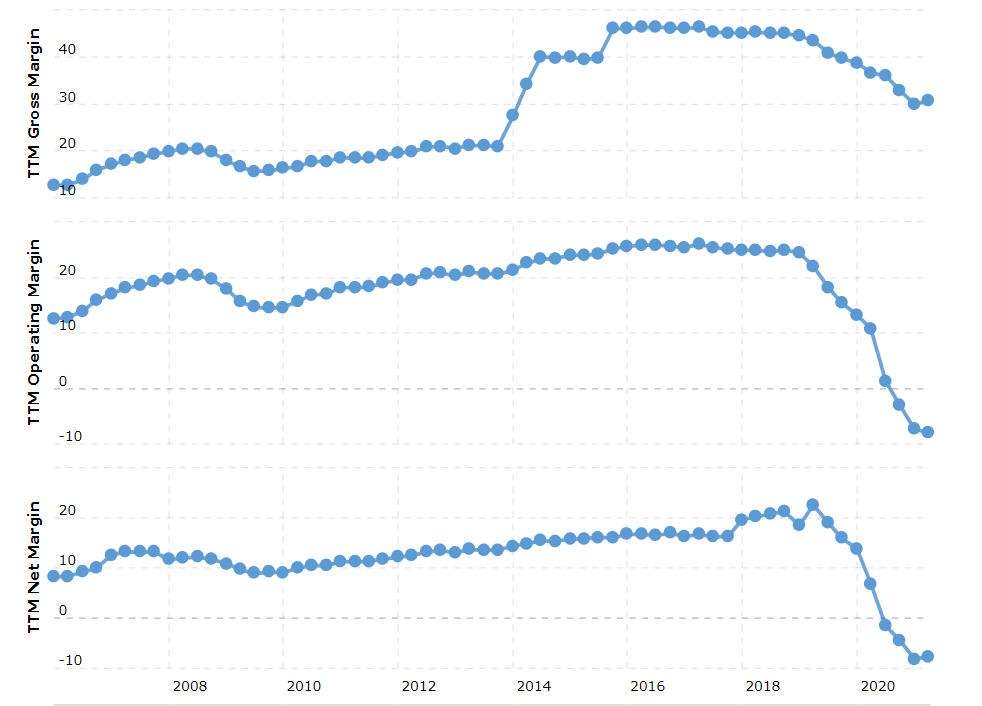Introduction
The Walt Disney Company is one of the most famous conglomerates, based on entertainment and media. This company owns amusement parks and water parks, a film studio, and broadcasting systems on various continents (The Walt Disney Company, 2021). The company’s history began in 1923 when cartoons from the pen of Walt Disney and his team began to appear at the studio in Hollywood (Iger, 2019). Success was not long in coming, and very soon, cartoon characters became the favorites of children and adults, who swept comics and various things with their image from the shops. The company also operates several television channels ranging from soap operas to sports (The Walt Disney Company, 2021). The vision of The Walt Disney Company is to be one of the world leaders in the production and provision of entertainment and information (The Walt Disney Company, 2021). The company plans to achieve this by inspiring and informing people worldwide through its channels, stories, creative solutions, and innovative technologies.
Mission
The social responsibility of the company is entirely consistent with its mission. Inspiration and comfort are provided primarily to young people through various financial and non-monetary programs that aim to fulfill desires, improve children’s hospitals, and invest in youth (The Walt Disney Company, 2021). Naturally, like any sizeable modern company, Disney’s social responsibility fully complies with the requirements of respect for human rights, control of safety, and product integrity. In addition, the company positions its content as positive, inclusive, and safe, suitable for people of all ages (The Walt Disney Company, 2021). Along with social responsibility, in accordance with modern trends, there is also environmental responsibility.
As part of protecting the environment, the company is reducing greenhouse gas emissions and conserving water resources. In addition, as part of the Disney Conservation program, the company maintains wildlife conservation, which is often reflected in the content of cartoons and films (The Walt Disney Company, 2021). According to the Abell model, all of Disney’s business segments are generally aimed at children: consumer goods, media, studios, and generally produce products with no age limit. Except for a few television and radio channels targeting an adult audience, the most popular are goods with famous cartoon characters, a stylized entertainment industry around the world, the primary audience of which is children and adolescents (Schickel, 2019). Therefore, colorfulness, fabulousness, matching images, and fun are fundamental factors that meet the primary audience’s needs. Technologies based on the Abell model meet the exact requirements – a modern website is made in bright colors. With the use of animation, any promotions, and alliances are exclusively entertaining in nature with the use of images familiar to everyone from childhood, and target groups are always chosen not only by children (Schickel, 2019). Parents and grandparents also fall into the target audience of this company, as they determine the leisure time for their children, and they also need to be aware of all events, promotions, and promotions of the company. The branded legendary images allow the company to satisfy the unmet needs of the audience quickly and are the distinctive competencies of the company.
Environmental Assessment
The majority of Disney’s revenue comes from its television channels. A huge family of different holdings, including the sports giant ESPN, generates more than 70% of advertising and other sources (Today Citadel, 2018). Film distribution suffers losses due to restrictions due to the pandemic, but various streaming services come to the rescue. In 2009 and 2012, Disney bought out Marvel Entertainment and Lucasfilm, respectively, gaining access to top-grossing projects like The Avengers and Star Wars (Today Citadel, 2018). In addition, the company earns a specific part of its income from its theme parks, one of which in Tokyo is part of a franchise sold and pays royalties. The company owns other parks in the world (Zornado, 2017). Disney accounts for a significant share of domestic gross domestic product in the cities where their theme parks are located.
Despite a reasonably large number of analogs, the legendary brand makes the park unique and, as a result, expensive. Disneyland ticket prices are well ahead of inflation, which constitutes a significant market trend (Blankenship, 2019). Despite the general upward trend in the company’s shares over the past five years, the diversification of multiple businesses does not make it attractive to investors. The overwhelming popularity of streaming services in late 2020 – early 2021 is due to restrictions due to the pandemic when most of the world’s population had to stay and work from home (Fiorillo & Gorwood, 2020). Whether the company will be able to sustain this success is a big question since television, on the one hand, is losing its audience due to streaming services, like cinemas, but Disney products and content are presented in wallpaper spheres, which complicates any predictions of market trends.
Disney is influenced by a combination of factors, according to a PESTLE analysis. The company is highly dependent on intellectual property laws at the political level (Douglas, 2019). It is also worth mentioning the stability of political situations, which was disrupted by the pandemic, which, as mentioned above, had its pros and cons for the company. Technologically, Disney can leverage the popularity of smartphones and online technologies and the development opportunities in augmented reality. The social issue of cultural diversity poses particular challenges for the company in content creation. Such a large number of opportunities for the company is only a matter of correct integration since the strength of the brand is genuinely great, and the marketing channels through which it can advertise products are just another addition. Despite the above opportunities, Disney is not a cutting-edge company in terms of innovation, which poses a threat to it, according to SWOT analysis.
Competitors also pose a threat to the company. A sufficiently high level of diversification of the company’s products implies competition in each area: sports channels represented by CBS, Sky, and Eurosport; Viacom CBS, Sony, and Comcast are also major competitors in the television market (Schickel, 2019). In cinematography, as in art, everything depends on the success of each product. The company once succeeded in capturing the market with the successful cartoons The Lion King, Aladdin, and Beauty and the Beast at the end of the 20th century (The Walt Disney Company, 2020). Having strengthened its success with various children’s TV series and film series, the company is also conquering the market through large purchases (Iger, 2019). However, the likes of Marvel movies – blockbusters – are constantly hitting the big screens and streaming services from other film companies that could take over the championship at any moment.
Internal Capabilities
Internal factors of the company support its reputation and strengths – the brand. Potential growth depends on the company’s flexibility and quick adaptation to a new market that has rapidly changed due to the pandemic. Diversification can be one of the development opportunities, especially in entering the emerging markets of mobile applications, online services, streaming, and augmented reality technologies. The company’s weaknesses are its conservative and reactive approach. While this approach is typical for giant firms in any field, it keeps Disney from breaking away from its competitors (Yang, 2019). Another critical point is the indicator of synergy in the context of diversification. The company developed extremely harmoniously, but now it tends to work in industries far from its primary activity, an example of which is the creation of ESPN.
The resources and capabilities of the company represent years of experience in television and industry. In addition to the fact that these advantages reflect the strength of the brand, the studios have all the necessary technical developments, the company has sufficient strength to finance and market its products. Distinctive competences include such experience in filmmaking, broadcasting and organizing TV channels, well-established platforms for advertising and methods and techniques of children’s entertainment – from visuality to involvement.
The financial trends of this company depend on the economy in the regions of the world, as they directly reflect the purchasing power of the target audience and the availability of products. Although access to theme parks is a premium product that is not available in large quantities to the middle class, the company’s primary revenue comes from television rights and advertising. As such, the company’s success and stock growth could mean a stronger Disney position and reputation in the marketplace and a strong purchasing power for the company’s major advertising customers.
Goals & Strategic Objectives
The main long-term goal of the company is to maintain the attention of its audience. Disney will grow if the company can entertain its already captured audience of children, teens, and adults through its content and channels (The Walt Disney Company, 2021). This approach is conservative and aims more at maintaining the vector of vertical development, although many emerging markets require horizontal growth. Disney may not risk damaging the brand’s uniqueness by opening theme parks in not just a few but many cities around the world. This event will require a considerable investment, but given the brand’s strength, it can be a good marketing ploy to popularize constantly released content.
The company’s long-term plans are also related to social and environmental responsibility. The company plans to move entirely to renewable resources, reduce harmful emissions to zero, create fully inclusive content that respects human rights that can entertain any minor or adult inhabitant of the planet (The Walt Disney Company, 2021). While the company’s vision mentioned a passion for innovation, it is the technological developments in the field of everyday life, and not just cinema and cartoon production, that can help the company achieve these social goals. In addition, this vector of development fully meets the acceptable level of risk, which is relatively low due to the brand’s strength.
Strategy
The company’s strategy is defined by several alternative approaches that realize its full potential only in perfect agreement. Local design, digital trends focus, and deepening consumer interaction are Disney’s main strategies for local markets, adapting shared content to meet the audience’s needs and adjusting marketing campaigns accordingly (Zhang, 2021). The company’s modern strategies in local markets are also aimed at healthy lifestyles, intelligent products that are becoming more interesting for children every day, and obtaining new licenses. Disney understands the power of the brand better than any other company, and as a result, it buys substantial and strategically essential companies, not only for filmmaking as a primary function but also as companies with rights to brands that already have cultural influence.
Consequently, the company’s overall mission is achieved through the challenges posed by each region where Disney operates. The study of such local strategies allows a better understanding of the mechanisms by which the primary vector of the company is achieved. Films and multi-series are, in fact, part of a large marketing company worldwide to focus the attention of the target audience on products that should meet recognition, branding, health promotion, and modern technology. Digital technology creates an indirect sense of engagement for every fan or child, which the company emphasizes. As stated above, online development and mobile apps are also essential for this engagement, which drives marketing, advertising, and promotions. Better distribution can also be facilitated by the games market, which in some countries is now more developed than the film market (Zhang, 2021). Consequently, the interactivity presented by this company through cartoons can be achieved with great success in the gaming industry, which is one of the strategies of companies in local markets.
Implementation
The organizational structure of a company is described by an M-form, which means a diversified structure. This structure is typical for diversified companies. Such an organization is hugely beneficial in terms of the outlined strategies. The different approach of each industry allows for a variety of perspectives, each of which will also differ in cultural aspects due to the multicultural nature of the company. The process of creating an idea at the intersection of industries, using years of experience in a film studio, television broadcasting, and creating related products, will immediately take into account all kinds of business processes in each of Disney’s areas, simplifying the application. This multi-divisional structure requires a complex hierarchy of management and reporting positions in each area and oversight of the company’s overall operations and alignment across industries.
Films produced by controlled studios are considered significant projects of the company. The number of studios has increased due to large purchases, which has increased the flow of filmmaking. Contemporary trends, to some extent, influence the cultural implications of many films, promoting equality and recognition of human rights. Most of the projects are related to the universes of Marvel and Star Wars. However, animated works that are classics for Disney continue to appear on screens. A massive project as a recommendation would be to launch theme parks in various cities around the world, which would contribute to the horizontal and regional development of the company, a better understanding of the needs of the local target audience, and an improvement of the international marketing experience.
Exhibits
Below, in Figures 1-4, the company’s financial performance is shown, which reflects stable growth even in the context of the pandemic, during which only net profit margin, operating margin, and investment fell. Analysts expect a quick recovery based on vaccination successes and government incentives, which is starting to come true. New industry forecasts predict record-high revenue growth rates across virtually all segments of the sector. On average, the rate will be over 8 percent. Disney stock yields are slightly declining but have good stability and prospects. Any outcome resulting from the restrictions due to the pandemic is good for the company – people at home are more likely to buy a Disney + subscription, while those hungry for the experience of large screens in cinemas and theme parks are waiting for the opportunity to visit them.




References
Blankenship, S. C. (2021). Walt Disney World as a model for brand marketing: an IMC approach to build brand loyalty [Thesis]. University of Mississippi. Web.
Douglas, C. (2019). It’s a small world after all: An international analysis of the Walt Disney Company. Journal of Undergraduate Research, 16, 1-6.
Fiorillo, A., & Gorwood, P. (2020). The consequences of the COVID-19 pandemic on mental health and implications for clinical practice. European Psychiatry, 63(1).
Iger, R. (2019). The ride of a lifetime: Lessons learned from 15 years as CEO of the Walt Disney Company. Random House.
Macrotrends. (2021). Disney (DIS). Web.
Schickel, R. (2019). The Disney version: The life, times, art and commerce of Walt Disney. Simon & Schuster.
The Walt Disney Company. (2021). About. Web.
The Walt Disney Company. (2020). Annual Reports. Web.
Today Citadel. (2018). The economics behind Disney: the formation of an empire. Web.
Yang, J. (2019, August). Analysis of business operation management under the Harvard analytical framework: a case study of the Walt Disney Company. In 1st International Symposium on Economic Development and Management Innovation (EDMI 2019) (pp. 112-125). Atlantis Press.
Zhang, Y. (2021, July). Disney IP Industry Development Strategy. In 2021 International Conference on Economic Development and Business Culture (ICEDBC 2021) (pp. 215-218). Atlantis Press.
Zornado, J. (2017). Capital, Crisis, and the Rise of Disney Fantasy. In Disney and the Dialectic of Desire (pp. 43-66). Palgrave Macmillan, Cham.
